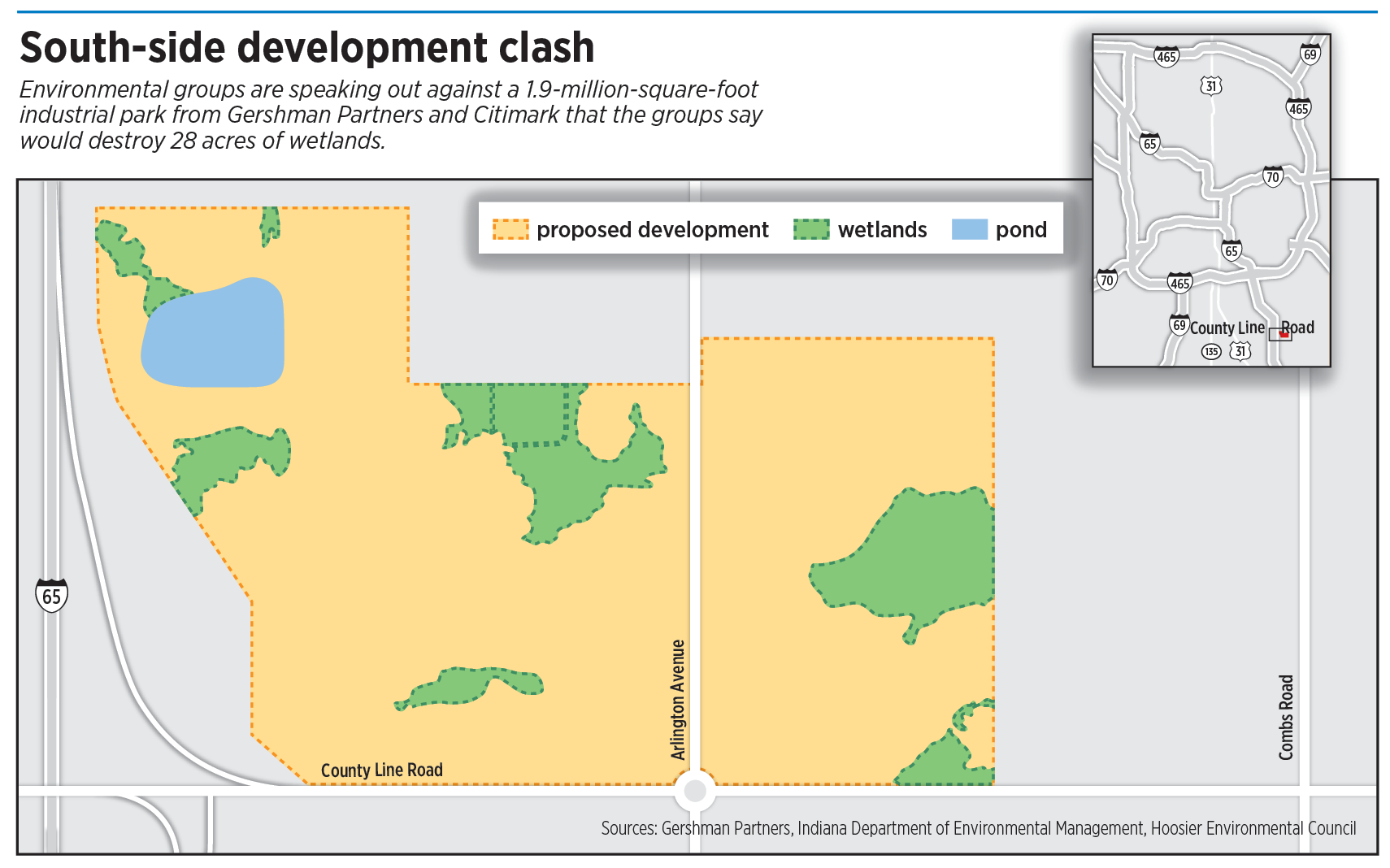Subscriber Benefit
As a subscriber you can listen to articles at work, in the car, or while you work out. Subscribe Now
To Robin Heldman, the proposed industrial and commercial development planned near her south-side home would bring about a change she has railed against since the former farmland was rezoned a little more than a year ago: the loss of deer, foxes, migratory birds and other wildlife she has enjoyed for 25 years.
“Their habitat is shrinking drastically,” Heldman said. “And then to just chokehold that area even tighter will have a significant impact.”
To the Hoosier Environmental Council and other environmental advocates, the project represents something more: the continued erosion of wetlands protections in Indiana.
“We’re now in an era of accelerated wetland loss, and this property is just a prime example of that,” Indra Frank, the council’s director of environmental health and water policy, told IBJ.

To Indianapolis-based developers Gershman Partners and Citimark, their plans to construct a five-building, 1.9-million-square-foot warehouse complex on a 170-acre south-side plot near Interstate 65 and the Marion-Johnson county line are simply following state and local regulations to a T.
Gershman and Citimark aim to begin construction in March. The site, which is now zoned industrial and includes 28 acres of wetlands, would be built out in phases, with completion in 2030.
Located near the intersection of County Line Road and Arlington Avenue, the project is in an area that, in addition to neighborhoods and apartment complexes, features a three-mile stretch of distribution and manufacturing facilities for companies such as Amazon and FedEx.
What began as Heldman and about 40 other local residents opposing a zoning change for the project has snowballed into an environmental-advocacy flash point; more than 2,300 people have signed a petition to oppose the development. The petition, led by the Hoosier Environmental Council, is opposing the issuance of a permit the developer needs in order to remove a quarter-acre of the wetlands.
Why just that slice? The parcel is all that’s left to object to in an attempt to protect the larger swath of wetlands after a 2023 U.S. Supreme Court decision limited federal wetlands regulation and a 2021 Indiana law amended state wetland protections.
An Indiana bill now proposes further changes to wetland regulation. Supporters of the measure say Indiana’s wetlands laws need clarification to ease what they deem an overreaching regulatory hurdle that complicates economic and housing development.
But the Hoosier Environmental Council says the debate reflects how loose wetland regulations have become. Even when developers follow existing laws, the council says, wetlands are destroyed.
Environmental opposition
Project opponents want the Indiana Department of Environmental Management to deny the permit for the project and hold a public hearing. Wetlands store and filter excess stormwater in order to replenish groundwater and provide essential habitats for half of Indiana’s small and declining species, the council says.
The quarter-acre is of the highest quality of wetlands, Class III. The state defines Class III wetlands as undisturbed or minimally disturbed by human activity and supportive of more than a minimal amount of wildlife. Class III wetlands also can be a type that is considered rare and ecologically important, such as an acid bog or cypress swamp.
Some types of wetlands are exempt from permit requirements, including Class I and Class II wetlands with an area of less than three-fourths of an acre. A Class I wetland is one that has at least 50% of its area disturbed by human activity or supports only minimal wildlife or aquatic habitat. A Class II wetland is either between the classification of Class I and Class III or is a wetland that would meet the definition of a Class I if it weren’t rare or ecologically important.

Although the proposed warehouse project lies on 28 acres of wetlands, only four acres require a permit for development, said Susie McGovern, senior water policy associate with the council. The four acres are Class III wetlands, and IDEM already has issued a permit for all but the final quarter-acre.
State regulations require those that remove Class III wetlands to mitigate the effects, which entails either paying into a state fund to replace wetlands or building wetlands elsewhere in the same watershed. In exchange for a permit to allow the development of the entire site, IDEM will require the developers to pay to preserve nine acres of forested wetlands from an area near the White River at a price of $80,000 per acre.
Gershman wrote in a permit application to IDEM that other properties in the area were considered for the project but the site at County Line Road and Arlington Avenue was selected because of its proximity to the interstate. The project would not be possible without removing Class III wetlands, Gershman wrote.
It’s unclear when IDEM will act on the permit application. But either side in the dispute could appeal IDEM’s decision.
City officials have approved tax breaks for the project that would save the developers more than $7 million over five years and have OK’d nearly $20 million in developer-backed tax-increment financing. The TIF funds would be used specifically to widen South Arlington Avenue and County Line Road and to construct a roundabout at the intersection.
Cathy Burton, president of the Franklin Township Civic League, has pushed back on the project alongside Heldman. She told IBJ she is not against the development itself—if Gershman and Citimark could build around the wetlands, she would be supportive.
“It may seem more expensive right now to try and properly safeguard and enhance those things,” Burton said. “But if we just keep putting off and kicking it down the road there, after a while there’s going to be no ability to fix it.”
The project has been downsized 30 acres, a move that removed 14 acres of wetlands from the site and left almost three acres more of isolated forested wetlands intact, according to IDEM documents.
In a statement, Gershman Partners Principal Ryan Gershman told IBJ the development includes preservation of “significant wetlands” and “will provide wildlife viewing amenities” to local residents.
“The project also includes significant onsite and offsite infrastructure investment and stormwater upgrades,” Gershman wrote. “We are proud that this project will produce hundreds of high-quality jobs for Indianapolis residents with a thoughtful site plan that is in full compliance with local, state, and federal requirements.”
Changing regulations
State and federal wetlands regulations have seen changes that environmental advocates say will only increase the speed at which these natural spaces disappear.
Senate Enrolled Act 389 of 2021 removed a requirement that builders who fill Class I wetlands buy credits to offset the environmental impact. The bill was authored by Republican Sens. Linda Rogers, Mark Messmer and Chris Garten, who are all members of the Indiana Builders Association.
Messmer and Garten declined to comment on environmental advocates’ view of the legislation. A spokesperson for Rogers did not respond in time for publication.
Now, the Indiana Builders Association is part of a new legislative push. CEO Rick Wajda said the organization supports a measure that the association says would clarify IDEM documentation in which many wetlands that were classified as Class II before Senate Enrolled Act 389 are now classified as Class III.
House Bill 1383 from Rep. Alan Morrison, R-Brazil, would address that issue. Morrison, who is not a member of the Indiana Builders Association but does operate a business that deals in security systems and garage doors, did not respond to an IBJ request for comment. The bill has been referred to the House Environmental Affairs Committee, which Morrison chairs.
Wajda said the legislation was the result of meetings with wetlands consultants, landowners and IDEM since the end of the 2023 session where discussions were held about the law’s language.
Wajda said his organization strives to lower regulatory costs for builders in order to lower the costs passed on to homeowners and provide “sorely needed” housing. Such costs can include the expense of hiring a contractor to identify wetlands, potential fees for mitigation and occasionally changed development plans.
He said the 2021 changes to Indiana wetlands law created a regulatory framework to protect high-quality wetlands but streamlined the process to develop in lower-quality isolated wetlands. He said those lower-quality wetlands “may be as much as a wet spot in the corner of a farm field that was never a wetland … but some wetland-type species popped up.”
Greg Ellis, vice president of environment and energy policy for the Indiana Chamber of Commerce, said his organization will likely support the latest legislative proposal. Ellis said the chamber had heard concerns related to the way IDEM applied certain definitions on its forms, and the bill should address those concerns.
“I think it’s a good bill in the right direction,” Ellis told IBJ. “It doesn’t appear to take away wetlands at this time.”
The chamber stood with environmental groups in opposition to SEA 389 in 2021.
Ellis said the chamber recognizes the ecological importance of wetlands.
To examine the availability of groundwater, the chamber has launched a water study. So far, Ellis said, an outside firm has determined that central Indiana will need more water storage as climate change creates drier summers and more extreme weather events. That water storage can come in the form of reservoirs and wetlands, he said.
“So [the Indiana Chamber] is still trying to protect and balance that interest,” he told IBJ. “You know, water is obviously important to business, the general public … so I mean, it’s of interest to everyone.”
Federal regulation also has seen a shift that directly impacts the Franklin Township building site. Before a U.S. Supreme Court decision last May that narrowed the scope of the Clean Water Act, 20 acres on the eastern side of the property would have been protected federally, Frank of the Hoosier Environmental Council told IBJ.
The court ruled that federal protections for wetlands under the Clean Water Act apply only to wetlands with a continuous surface connection to federally protected waterways that make them “indistinguishable” from those waters. It left all other wetlands up to state regulations.
A wetlands task force
The 2021 state law also included a provision establishing a task force focused on Indiana’s wetlands.
Indiana is estimated to have lost about 85% of its original wetlands since the 1780s, IUPUI researcher Robert Barr told the task force in 2022.
According to a study from 13 environmental organizations released in September, the state has lost 260 acres of wetland since the 2021 law went into effect.
A final report from the task force stated that Indiana is at a point where the cumulative loss of wetlands is having “a measurable negative impact on residents, particularly from a water quality and flooding standpoint.”
A 2022 report prepared by the environmental advocacy not-for-profit White River Alliance said more than 80% of the land surrounding the Indianapolis, Lawrence and Beech Grove portions of the White River is urbanized, with only 6% used for natural spaces such as wetlands, forests and shrubland.
About 11% is used for agriculture.
South-side residents are used to seeing warehouses crop up in rural areas of Johnson County.
For Heldman, the debate is a question of, “When do you say, ‘Enough is enough?’” At some point, she said, the goals of progress or development might not be worth the environmental damage.•
Please enable JavaScript to view this content.

